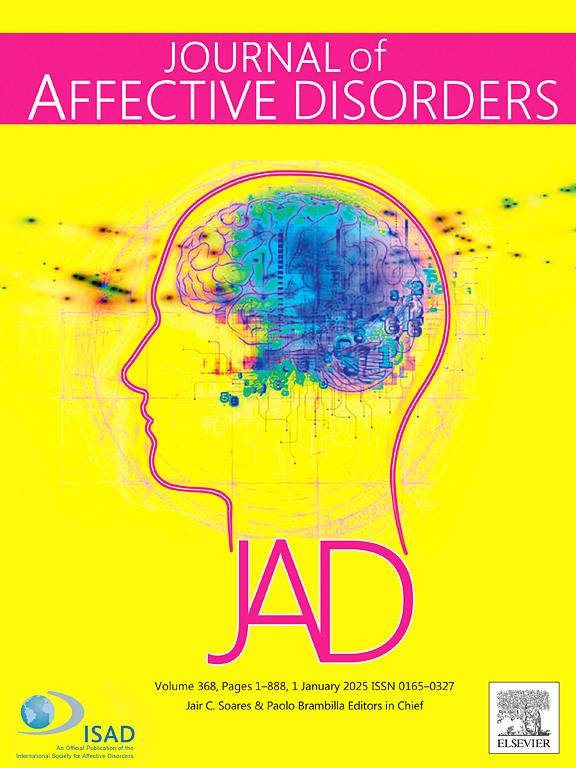smri引导下的rTMS对重度抑郁症脑功能和结构的影响。
IF 4.9
2区 医学
Q1 CLINICAL NEUROLOGY
引用次数: 0
摘要
背景:重度抑郁症(MDD)是世界范围内致残的主要原因。结构磁共振成像(sMRI)引导下的重复经颅磁刺激(rTMS)已成为一种很有前途的非侵入性治疗方法。然而,其功效背后的神经机制尚不清楚。方法:对33例重度抑郁症患者和42例健康对照者进行静息状态功能MRI和结构MRI扫描。在重度抑郁症患者中,30名患者在接受smri引导的rTMS治疗10次,时间超过2周后进行了重新扫描。分析治疗前后的低频波动幅度(ALFF)、静息状态功能连通性(rsFC)和灰质体积(GMV)。计算rTMS后脑成像变化与临床结果的相关性。结果:在基线时,与健康对照组相比,MDD患者表现出右侧角回、右侧额上回(SFG)和左侧楔前叶ALFF下降,左侧下顶叶(IPL)和右侧颞中回(MTG) ALFF增加。rTMS治疗后,大鼠右侧角回和右侧后脑区ALFF升高,右侧角回和左侧后脑区之间rsFC降低。治疗后GMV未见明显变化。这些神经影像学改变与临床疗效无显著相关性。结论:这些发现表明,smri引导的rTMS可能诱导MDD患者角回和SFG局部功能活动的恢复,以及默认模式网络(DMN)异常功能连接的正常化。然而,相关分析表明,这些变化可能不一定代表smri引导的rTMS治疗效果的神经影像学机制。本文章由计算机程序翻译,如有差异,请以英文原文为准。
Effects of sMRI-guided rTMS on brain function and structure in major depressive disorder
Background
Major depressive disorder (MDD) is a leading cause of disability worldwide. Repetitive transcranial magnetic stimulation (rTMS) guided by structural magnetic resonance imaging (sMRI) has emerged as a promising non-invasive treatment. However, the neural mechanisms underlying its efficacy remain unclear.
Methods
Thirty-three MDD patients and forty-two healthy controls underwent resting-state functional MRI and structural MRI scans. Among the MDD patients, thirty were rescanned after receiving 10 sessions of sMRI-guided rTMS over 2 weeks. Amplitude of low-frequency fluctuations (ALFF), resting-state functional connectivity (rsFC), and gray matter volume (GMV) were analyzed before and after treatment. The correlations of brain imaging changes after rTMS with clinical outcomes were calculated.
Results
At baseline, compared to the healthy controls, MDD patients exhibited decreased ALFF in the right angular gyrus, right superior frontal gyrus (SFG), and left precuneus, as well as increased ALFF in the left inferior parietal lobe (IPL) and right middle temporal gyrus (MTG). Following rTMS treatment, ALFF in the right angular gyrus and right SFG increased, while rsFC between the right angular gyrus and left MTG decreased. No significant changes in GMV were observed post-treatment. These neuroimaging changes were not significantly correlated with clinical efficacy.
Conclusions
These findings indicate that sMRI-guided rTMS may induce restoration of local functional activity in the angular gyrus and SFG, as well as normalization of aberrant functional connectivity within the default mode network (DMN) in MDD patients. However, correlation analyses indicate these changes may not necessarily represent the neuroimaging mechanisms underlying sMRI-guided rTMS treatment effects.
求助全文
通过发布文献求助,成功后即可免费获取论文全文。
去求助
来源期刊

Journal of affective disorders
医学-精神病学
CiteScore
10.90
自引率
6.10%
发文量
1319
审稿时长
9.3 weeks
期刊介绍:
The Journal of Affective Disorders publishes papers concerned with affective disorders in the widest sense: depression, mania, mood spectrum, emotions and personality, anxiety and stress. It is interdisciplinary and aims to bring together different approaches for a diverse readership. Top quality papers will be accepted dealing with any aspect of affective disorders, including neuroimaging, cognitive neurosciences, genetics, molecular biology, experimental and clinical neurosciences, pharmacology, neuroimmunoendocrinology, intervention and treatment trials.
 求助内容:
求助内容: 应助结果提醒方式:
应助结果提醒方式:


